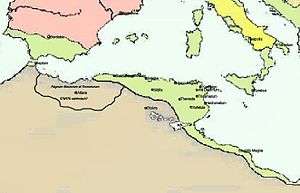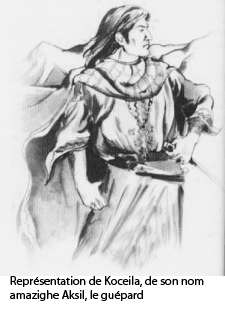Mauro-Roman kingdom

The Mauro-Roman kingdom (Regnum Maurorum et Romanorum) was a Berber kingdom that existed in the Maghreb between the fourth century and the conquest of the region by the Umayyad Caliphate. Beginning in the sixth century, the polity's realm shrunk and it came to be known as the Kingdom of Altava,[1] after its capital Altava.
Characteristics
In 298 AD, Emperor Diocletian consolidated the Roman Empire. He later withdrew from the area of Volubilis, the Rif mountains in northern Morocco and western Algerian Atlas mountain during and after the Imperial Crisis. Berber rulers created a small independent kingdom, centered around the capital Altava and the fully romanised city of Volubilis.
This kingdom was a vassal state of the Roman empire, but sometimes the Berber tribes living in the territory raided the Roman cities of the coast. The Mauro-Roman kingdom was never conquered by the Vandals, who destroyed the Roman presence in the Maghreb in 429-435 AD. The Vandal kingdom allowed the creation of other Romano-Berber states at the borders, but fell a century later, conquered by the Byzantine empire, who established an African prefecture, and later the Exarchate of Carthage. Since then there it is little historical accounts of the Mauro-Roman kingdom. It disappeared completely when the Arabs conquered the region around 708 AD.[2]
History
Mauretania and western Numidia were annexed by Rome in 40 AD, and made a Roman Province in 43 AD and later enlarged with the name of Mauretania Tingitana ad Mauretania Caesariensis. But in the fourth century the Roman Empire lost an area in the border of actual Maroc and Algeria to the local Berber tribes.
Indeed, Maximian (co-emperor with Diocletian) at the end of the third century was able to focus on the conflict in Mauretania (Northwest Africa).[3] As Roman authority weakened during the third century, nomadic Berber tribes harassed settlements in the region with increasingly severe consequences. In 289 AD, the governor of Mauretania Caesariensis (roughly modern Algeria) gained a temporary respite by pitting a small army against the Bavares and Quinquegentiani, but the raiders soon returned. In 296 AD, Maximian raised an army, from Praetorian cohorts, Aquileian, Egyptian, and Danubian legionaries, Gallic and German auxiliaries, and Thracian recruits, advancing through Spain that autumn.[4] He may have defended the region against raiding Moors[5] before crossing the Strait of Gibraltar into Mauretania Tingitana (roughly modern Morocco) to protect the area from Frankish pirates.[6]
By March 297 AD, Maximian had begun a bloody offensive against the Berbers. The campaign was lengthy, and Maximian spent the winter of 297–298 AD resting in Carthage before returning to the field.[7] Not content to drive them back into their homelands in the Atlas Mountains – from which they could continue to wage war – Maximian ventured deep into Berber territory. The terrain was unfavorable, and the Berbers were skilled at guerrilla warfare, but Maximian pressed on. Apparently wishing to inflict as much punishment as possible on the tribes, he devastated previously secure land, killed as many as he could, and drove the remainder back into the Sahara.[8] His campaign was concluded by the spring of 298 AD.
At the turn of the fourth century, parts of Roman Mauretania were re-conquered by Berber tribes. Direct Roman rule became confined to a few coastal cities (such as Septum (Ceuta) in Mauretania Tingitana and Caesarea in Mauretania Caesariensis) by the late 3rd century.[9] Historical sources about inland areas are sparse, but these were apparently controlled by local Berber rulers who, however, maintained a degree of Roman culture, including the local cities, and usually nominally acknowledged the suzerainty of the Roman Emperors.[10]
One of these rulers, Masuna, described himself as Rex gentium Maurorum et Romanorum ("King of the Roman and Moorish peoples"). Masuna is known only from an inscription on a fortification in Altava (modern Ouled Mimoun, in the region of Oran), dated 508 AD, and he is known to have possessed Altava and at least two other cities, Castra Severiana and Safar, as mention is made of officials he appointed there.[11]
The Western kingdom more distant from the Vandal kingdom was the one of Altava, a city located at the borders of Mauretania Tingitana and Caesariensis....It is clear that the Mauro-Roman kingdom of Altava was fully inside the Western Latin world, not only because of location but mainly because it adopted the military-religious-sociocultural-administrative organization of the Roman Empire...[12]
Altava was later the capital of another ruler, Garmul or Garmules, who resisted Byzantine rule in Africa but was finally defeated in 578 AD.:[13] because of the capital, the kingdom was started to be called Kingdom of Altava. Indeed, in the late 560s, the Moorish king Garmul of the "Regnum Maurorum et Romanorum" launched raids into Roman territory, and although he failed to take any significant town, three successive generals (the praetorian prefect Theodore and the magister militum Theoctistus in 570 AD, and Theoctistus' successor Amabilis in 571) are recorded by John of Biclaro to have been killed by Garmul's forces.[14] His activities, especially when regarded together with the simultaneous Visigoth attacks in Spania, presented a clear threat to the province's authorities. Garmul was not the leader of a mere semi-nomadic tribe, but of a fully-fledged barbarian kingdom, with a standing army.
Thus, the new Roman emperor, Tiberius II Constantine, re-appointed Thomas as praetorian prefect of the Exarchate of Carthage, and the able general Gennadius was posted as magister militum with the clear aim of reducing Garmul's kingdom. Preparations were lengthy and careful, but the campaign itself, launched in 577–78 AD, was brief and effective, with Gennadius utilizing terror tactics against Garmul's subjects. Garmul was defeated and killed by 579 AD, and the coastal corridor between Tingitana and Caesariensis secured.[15]

The Byzantine historian Procopius also mentions another independent ruler, Mastigas, who controlled most of Mauretania Caesariensis in the 530s.But some historians argue that Mastigas and Masuna were the same king.[16]
In the late fifth and early sixth century Christianity grew to be the main religion in the Berber kingdom, even if mixed with huge influences & presences of the autochthonous pagan religions. A new church (discovered recently) was built in the capital Altava in this period.[17]
Caecilius, called Koceila or Kusaila ("leopard" in Tamazight), was the last ruler of this kingdom. He died in the year 690 AD fighting against the Muslim conquest of the Maghrib. He was a 7th-century Berber Christian king of this Mauro-Roman kingdom (now called kingdom of Altava) and leader of the Awraba tribe of the Imazighen and possibly Christian head of the Sanhadja confederation. He is known for having led an effective Berber martial resistance against the Umayyad Caliphate's conquest of the Maghreb in the 680s.
Indeed, in 683 AD Uqba ibn Nafi was ambushed and killed in the Battle of Vescera near Biskra by Kusaila, who forced all Arabs to evacuate their just founded Kairouan and withdraw to Cyrenaica. But in 688 AD Arab reinforcements from Abd al-Malik ibn Marwan arrived under Zuhair ibn Kays. Caecilius met them in 690 AD -with the support of Byzantine troops- at the Battle of Mams. Vastly outnumbered, the Awraba and Byzantines were defeated and Caecilius was killed.
With the death of Caecilius, the torch of resistance passed to a tribe known as the Jerawa tribe, who had their home in the Aurès Mountains: his Christian berber troops after his death fought later under Kahina, the last Queen of the romanized Berbers.
Notes
- ↑ Map showing the reduced "Kingdom of Altava" with the other Romano-Moorish kingdoms
- ↑ Diehl,Charles."L'Afrique Byzantine. Histoire de la Domination Byzantine en Afrique (533–709)" p. 580-598
- ↑ Barnes, Constantine and Eusebius, 16; Southern, 150; Williams, 75.
- ↑ Barnes, New Empire, 59; Williams, 75.
- ↑ Barnes, Constantine and Eusebius, 16.
- ↑ Williams, 75.
- ↑ Barnes, Constantine and Eusebius, 16; Barnes, New Empire, 59.
- ↑ Odahl, 58; Williams, 75.
- ↑ Wickham, Chris (2005). Framing the Early Middle Ages: Europe and the Mediterranean, 400 - 800. Oxford University Press. p. 18. ISBN 978-0-19-921296-5.
- ↑ Wickham, Chris (2005). Framing the Early Middle Ages: Europe and the Mediterranean, 400 - 800. Oxford University Press. p. 335. ISBN 978-0-19-921296-5.
- ↑ In full, the inscription reads: "Pro sal(ute) et incol(umitate) reg(is) Masunae gent(ium) Maur(orum) et Romanor(um) castrum edific(atum) a Masgivini pref(ecto) de Safar. Iidir proc(uratore) castra Severian(a) quem Masuna Altava posuit, et Maxim(us) pr(ocurator) Alt(ava) prefec(it). P(ositum) p(rovinciae) CCCLXVIIII". The three officials are Masgiven in Safar, Iidir in Castra Severiana (exact location uncertain) and Maximus in Altava. 469 is provincial founding date, meaning 508. From Graham (1902: p.281). See also Martindale (1980: pp. 536, 734) and Merrills (2004: p.299).
- ↑ Noé Villaverde, Vega: "El Reino mauretoromano de Altava, siglo VI" (The Mauro-Roman kingdom of Altava) p.355
- ↑ Aguado Blazquez, Francisco (2005). El Africa Bizantina: Reconquista y ocaso (PDF). p. 46.
- ↑ PLRE IIIa, p. 504
- ↑ El Africa Bizantina, pp. 45-46
- ↑ Masuna and Mastigas
- ↑ Mauretania Caesariensis: an archaeological and geographical survey, by Lawless R.
Bibliography
- Barnes, Timothy . The New Empire of Diocletian and Constantine. Cambridge, MA: Harvard University Press, 1982. ISBN 0-7837-2221-4
- Camps, G. Rex gentium Maurorum et Romanorum. Recherches sur les royaumes de Maurétanie des VIe et VIIe siècles
- Diehl, Charles (1896). L'Afrique Byzantine. Histoire de la Domination Byzantine en Afrique (533–709) (in French). Paris, France: Ernest Leroux.
- Modéran, Y. Kusayla, l'Afrique et les Arabes. In "Identités et Cultures dans l'Algérie Antique", University of Rouen, 2005 (ISBN 2-87775-391-3).
- Conant, Jonathan (2012). Staying Roman : conquest and identity in Africa and the Mediterranean, 439-700. Cambridge New York: Cambridge University Press. pp. 280–281. ISBN 0521196973.
See also
- Kingdom of Altava
- Exarchate of Carthage
- Berbers and Christianity
- Roman-Moorish kingdoms